Connecting a gas stove with an electric oven: installation procedure + rules and regulations for connection
The modern household appliances market provides potential buyers with a wide range of gas stoves. One of the popular purchasing options are combined-type models, where, along with a gas resource, an electric one is also used. However, for buyers of such equipment, connecting a gas stove with an electric oven often raises questions. Do you agree?
Indeed, if you study the rules for handling gas and electricity, you can see that they clearly separate the marked resources. Accordingly, the practice of connecting hybrid gas stoves has some peculiarities. Let's consider these issues in more detail, paying attention to installation standards and rules for connecting to electricity and gas supply systems.
The content of the article:
Equipment installation instructions
Theoretically, the user himself can install (place) a gas stove on his own. Moreover, each model of a gas stove purchased officially must be accompanied by a user manual. This document specifically describes all the nuances of installing equipment on site.
It’s a completely different matter when the device is connected directly to the gas and electrical networks. Of those nuances of installing equipment on site that are noted in the documentation, one of the first is to ensure proper ventilation of the room, where the hybrid cooker is installed.
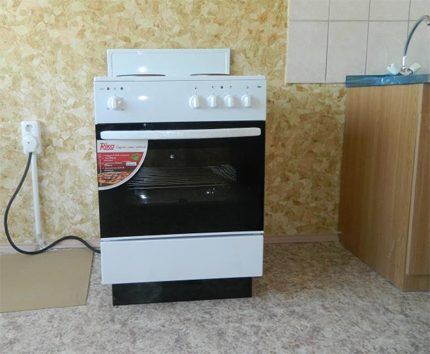
Next, we will consider how to choose a place for installation, taking into account the requirements and features of leveling the hybrid slab.
Requirements for installing a slab
This type of household appliance can be placed in the opening between the elements of kitchen furniture. In this case, on one side of the stove it is allowed to place a piece of furniture whose height is greater than the height of the gas stove. But, according to the rules, such furniture is placed at a distance of no less than 300 mm from the equipment body.
A piece of furniture placed on the other side of the equipment may be placed provided it is at the same height as the stove. If you plan to install some furniture elements above a gas stove, such installation is possible only if there is no impact on the operating process of the equipment.
Based on the rules, for such cases the minimum permissible vertical distance from the surface with burners is at least 650 mm, and indentation to hood - at least 75 cm.
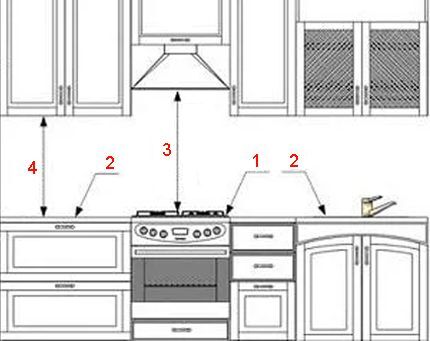
Taking into account the same rules for installing equipment locally, certain requirements also apply to pieces of furniture, as well as to walls, partitions, and floors that are located next to heating equipment.
In particular, furniture must have a heat-resistant structure that can withstand heat of 90 °C and above.One thing to take into account is the significant heating of the rear area of the gas stove as the equipment is used.
Optional stand and leveling
Many models of gas combination stoves come complete with a stand. Using a stand slightly increases the overall height (by about 5-10 cm).
The use of the stand is convenient because this piece of equipment is equipped with wheels (two wheels) and adjusting screws (two screws). There are also designs of gas stoves with four adjusting screws.
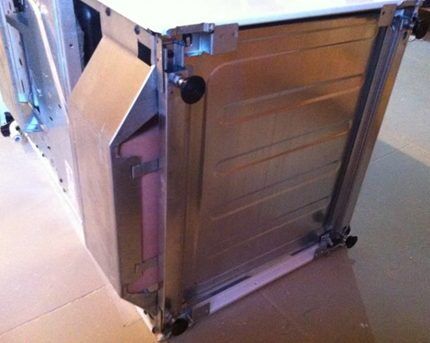
If it is convenient to move equipment with the help of wheels, then by adjusting the screws the gas stove is easily leveled to the horizon or to the level of the surfaces of the furniture set.
Meanwhile, the stand can be removed if necessary. In this case, the adjusting screws are installed directly on the bottom of the gas stove.
Connection rules and steps
The main rule of installation work aimed at connecting household appliances to gas and electricity supply lines is to involve specialists in this matter - representatives of the gas service, electricians.
It is useful for the user to understand how a gas stove with an electric oven is connected to the networks, but in practice this task should only be solved by specialists - service workers who have the appropriate clearance.
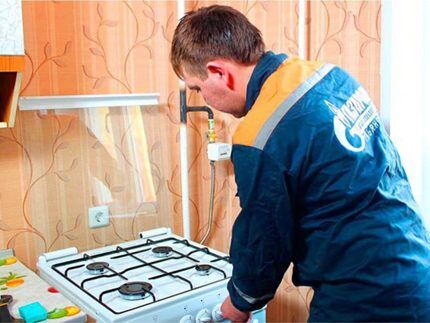
Each model of gas (combined) stove has technical documentation, which indicates the characteristics of the gas and electrical networks for connection.
Accordingly, resource network lines connected to the equipment installation site must comply with the specified technical characteristics of the equipment.
In particular, we mean the following characteristics:
- gas pressure;
- gas type;
- voltage of the electrical network.
The gas combination stove is supplied for sale, configured for use with natural gas “H”, “E”, supplied at a pressure of 13-20 mbar. Or an installation for the use of liquefied gas at a pressure of 20 mbar can be used. This information can usually be seen if you open the oven door, on the upper or lower end of the body.
Stage #1 - connecting the gas line
Like most classic models, the combined design of the gas stove is equipped with an R ½ nozzle (extended threaded tube). The connection to the main gas line is made using flexible hose, specially certified for use on a gas stove.
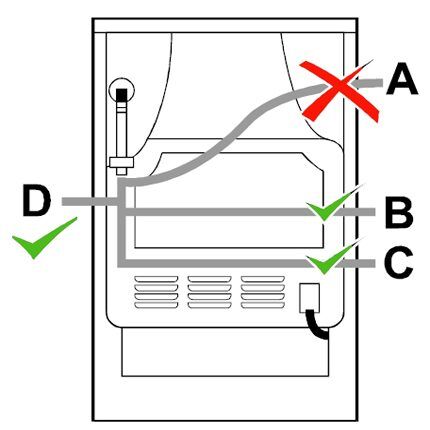
When installing a gas stove with an electric oven and connecting it to the gas pipeline line, the flexible connecting hose should be placed in such a way that there is no contact of the hose body with any part of the stove body.
After completing the connection, it is necessary to conduct a leak test at the joining points.
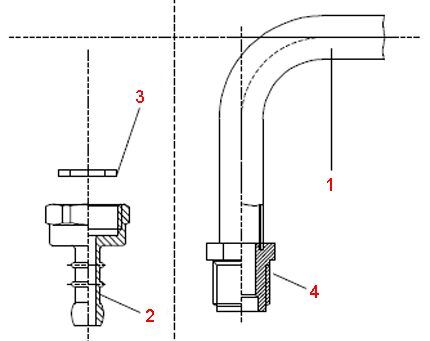
Also in the case of a flexible hose connection, the level matching rule must be taken into account. In particular, it is not allowed to raise the body of the flexible hose to the level of the entry point of the nozzle with the R ½ nozzle or above this level. True, if a rigid metal pipe is used for connection, the rule of levels is excluded.
Stage #2 - connecting the electrical line
The location of the electrical connection terminal is the rear wall of the gas (hybrid) stove housing. Typically, the terminals are hidden inside an insulated housing that has a circuit cover.
The box cover can be removed easily - just press the latch with a screwdriver and then push it up. The terminal configuration opens, where the supply cable conductors are connected.
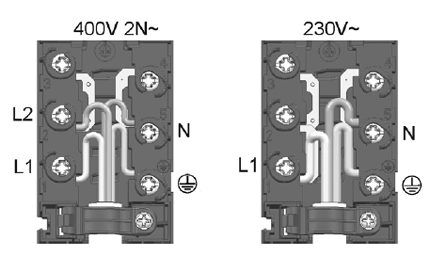
The connection of the power cable conductors should be carried out according to the markings indicated on the terminal base or on the documentation diagram.In this case, it is necessary to comply with the parameters of the electrical network used - using the correct connection configuration.
Typically the following is used conductor color combination on the network cables of combined home cookers:
- Voltage lines (L1, L2, L3) – black, black, brown.
- Neutral line - blue.
- Protective grounding (PE) – green-yellow.
After making the connections, the cable body inside the terminal box must be secured, thus preventing possible stretching and breakage. Then close the box lid tightly.
We should also not forget about the need for regular maintenance and performance testing of gas-using equipment. What is it for? enter into a contract with the gas company.
Conclusions and useful video on the topic
The video below demonstrates step-by-step installation of the equipment. The video touches on certain nuances of installation, compliance with rules and regulations:
Installing a household hybrid gas stove complemented by an electric oven is, by and large, not difficult. Another question is that the connection of this type of equipment should be carried out according to specially established rules that determine safety issues. Therefore, it is not possible to carry out the connection work independently (prohibited by the rules), even if you have some skills, knowledge and ability.
Do you have a different opinion about connecting a hybrid cooker to the electricity and gas supply system? Share it in the comments block. If you have questions on the topic of the article that we have not discussed above, ask them to our experts and other site visitors, and participate in discussions.




Are there regulations regarding gas pipe and hybrid stove? In the apartment, the gas pipe runs vertically in the center, relative to the gas stove. Is it possible to put a hybrid one in its place?